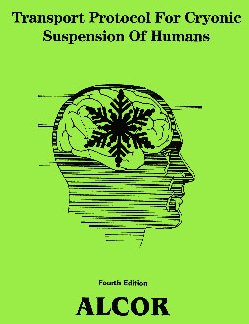Indirect Mind Uploading:
Using AI to Avoid Staying Dead
Paul Almond
page 2 of 13
Ettinger[1] and Cooper[2] attempted to address this problem in the 1960s by introducing the idea of cryonic suspension[3]. The word cryonics is a contraction of cryogenics, which means the science of low temperatures. The idea is actually quite simple: when a person is considered dead, by our standards, the body is preserved by means of extreme cold to prevent dissolution occurring, the idea being that technology decades or centuries in the future will have advanced to the point where the individual is no longer considered dead, but is merely considered damaged and can be restored to health.

Image 2: Alcor's 1990 transport manual, written by Michael Darwin, was a landmark in the evolution of procedures for human cryopreservation. Copyright http://www.alcor.org
Reviving a person who has been preserved in this way would not be trivial and cryonics advocates do not tend to pretend otherwise. For a start, the individual would have whatever damage caused cessation of functioning in the first place. He/she would also have a lot of secondary damage that occurred as a result of cessation of functioning, for example, as a result of cells in the body being deprived of oxygen. In addition the use of low temperatures, typically provided by liquid helium or liquid nitrogen, to preserve the individual seems likely to cause damage at the cellular level. Proponents of cryonics suggest using chemicals that serve an antifreeze function, preventing damage due to freezing, although these introduce some complications. They point to the idea of molecular nanotechnology, mentioned previously, and suggest that this would provide the capability to repair the damage at a cellular level, allowing the individual to be thawed and revived.
I am not going to discuss cryonics in detail here; after all, this article is examining life extension from an AI perspective, but readers will be divided into two categories: those who take the cryonics idea seriously and those who do not. Even those who take it seriously would tend to admit that there are risks of failure associated with it. If another solution could be found that could be used in addition to cryonics it could be considered a plausible insurance policy. For anyone who does not take the cryonics idea seriously, yet still wants life extension, another solution is needed. In either case we could still do with another loophole.
Using "Mind Uploading" to Avoid Staying Dead
"There were millions of men, doomed in earlier ages, who now lived active and happy lives thanks to artificial limbs, kidneys, lungs and hearts. To this process there could be only one conclusion- however far off it might be.
And eventually even the brain might go. As the seat of consciousness, it was not essential; the development of artificial intelligence had proved that."
- 2001: A Space Odyssey, Arthur C. Clarke (b. 1917CE)
The cryonics idea suggests that life extension can be achieved by preserving your brain and sending it into the future. The mind uploading idea[4, 5] goes beyond this and suggests that, perhaps, you can stay alive even after your brain is destroyed. The idea has been used quite a lot in science fiction, a good example being Greg Egan’s novel Permutation City[6], in which wealthy people use mind uploading to live in virtual reality simulations after their biological lives have ended.
Footnotes
1. Ettinger, R.C.W. (1964). The Prospect of Immortality. New York: Doubleday. (back to top)
2. Cooper, E. (writing as During, N.). (1962). Immortality: Physically, Scientifically, Now. Privately published. (back to top)
3. Alcor Life Extension Foundation. Retrieved June 22, 2003 from http://www.alcor.org/ (back to top)
4. Strout, J. Mind Uploading Home Page. (2002). Retrieved June 22, 2003 from http://www.ibiblio.org/jstrout/uploading/MUHomePage.html
(back to top)
5. Mind Uploading Research Group. (2002). Retrieved June 22, 2003 from http://minduploading.org/ (back to top)
6. Egan, G. (1994). Permutation City. London: Millennium. (Fiction). (back to top)